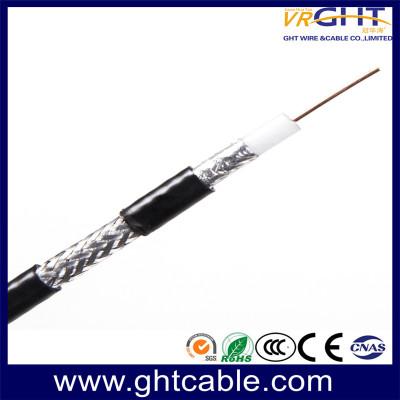
What Is the Difference Between RG59 and RG6 Coaxial Cables?
Coaxial cables are a staple in modern communication systems, connecting everything from televisions and internet modems to CCTV security systems. Among the most commonly used coaxial cables are RG59 and RG6, both widely employed in residential and commercial applications. Understanding the differences between these two cable types is essential for ensuring optimal signal transmission, system reliability, and cost efficiency.
At VRGHT, we specialize in providing high-quality coaxial cables, including RG59 and RG6, tailored to a variety of applications. We often help clients determine which cable type best fits their specific requirements, whether it's for a home entertainment setup, security cameras, or broadband networks.
What Are RG59 and RG6 Coaxial Cables?
RG59 Coaxial Cable is a thin, flexible cable with a smaller core conductor, typically 20 or 22 gauge. It is commonly used for CCTV systems, analog video transmission, and short-distance signal delivery. RG59 offers good signal integrity over shorter distances, making it suitable for indoor applications where cable runs are relatively short.
RG6 Coaxial Cable, on the other hand, features a thicker center conductor and enhanced shielding. This cable type is designed to handle higher frequencies, making it ideal for satellite TV, broadband internet, and high-definition video transmission. The thicker design and better shielding reduce signal loss and interference, allowing for longer cable runs compared to RG59.
Key Differences Between RG59 and RG6
1. Signal Transmission and Frequency Support
RG59 is suitable for lower-frequency signals, typically below 750 MHz, which makes it sufficient for standard-definition video and short-distance analog applications.
RG6 supports higher frequencies up to 1 GHz or more, enabling it to handle HD television signals, digital satellite broadcasts, and fast broadband internet without noticeable signal degradation.
2. Cable Construction
The main structural differences between RG59 and RG6 include:
- Center Conductor: RG6 usually has a thicker copper core, providing lower resistance and better conductivity than RG59.
- Insulation and Shielding: RG6 often comes with dual or quad shielding (foil plus braid), while RG59 typically has a single braid shield. The enhanced shielding in RG6 protects signals from electromagnetic interference (EMI) and crosstalk.
- Outer Jacket: Both cable types feature protective jackets, but RG6 is generally sturdier and more suitable for outdoor or longer cable runs.
3. Maximum Cable Length
Due to lower attenuation, RG6 can transmit signals over longer distances than RG59. For example, a CCTV camera setup spanning more than 200–300 feet would benefit from RG6 to maintain signal quality. RG59 is more suited for cable runs under 150 feet for video transmission, especially analog CCTV installations.
4. Applications
RG59 Applications:
- Short-distance CCTV systems
- Analog video connections
- Older home entertainment setups
- Low-frequency signal transmission
RG6 Applications:
- Satellite TV installation
- HD or 4K television systems
- Broadband internet distribution
- Long-distance CCTV systems or high-frequency video applications
5. Installation Considerations
RG59 is thinner and more flexible, making it easier to maneuver in tight spaces or through walls. However, its smaller core and lighter shielding make it less suitable for long runs or outdoor environments.
RG6, while slightly stiffer, provides superior signal quality over long distances and can withstand environmental factors when using outdoor-rated or weatherproof jackets. At VRGHT, we supply RG6 cables specifically engineered for both indoor and outdoor installations, ensuring reliability and durability.
6. Cost Comparison
In general, RG59 is less expensive than RG6, making it attractive for budget-conscious projects. However, for installations that require higher signal integrity, long-distance transmission, or modern broadband compatibility, RG6 offers better value and future-proofing despite the higher initial cost.
Why Choosing the Right Coaxial Cable Matters
Choosing the appropriate coaxial cable impacts signal clarity, network performance, and long-term reliability. Using RG59 where RG6 is required may lead to signal degradation, interference, or connectivity issues. Conversely, using RG6 in short, low-frequency applications may slightly increase cost but provides added durability and peace of mind.
At VRGHT, we guide our clients in selecting the correct cable type based on their specific requirements. Whether you're upgrading your home security system, installing a high-definition television setup, or setting up a commercial network, we ensure that every cable meets international quality standards and performs reliably for years to come.
Tips for Installing RG59 and RG6 Cables
Use the Correct Connectors: F-type connectors are commonly used for both RG59 and RG6. Ensure compatibility with your devices.
Avoid Sharp Bends: Coaxial cables are sensitive to kinks, which can cause signal loss.
Check Cable Length: Minimize cable runs to reduce attenuation, or choose RG6 for longer distances.
Shielding Matters: In high-interference areas, prioritize RG6 with quad shielding for optimal performance.
Weatherproof Outdoor Installations: Use cables rated for outdoor use to withstand UV exposure and moisture.
Conclusion
Both RG59 and RG6 coaxial cables have their place in modern communication systems. RG59 remains ideal for short-distance, analog, or budget-conscious installations, while RG6 provides superior performance for HD video, broadband internet, and long-distance signal transmission.
At VRGHT, we supply high-quality RG59 and RG6 cables tailored to residential, commercial, and industrial applications. By selecting the right cable for your project, you can ensure signal integrity, reliable performance, and long-term value. Our team is committed to providing expert guidance, so whether you're setting up a home CCTV system or a complex broadband network, VRGHT has the right coaxial solution for you.










Leave a comment